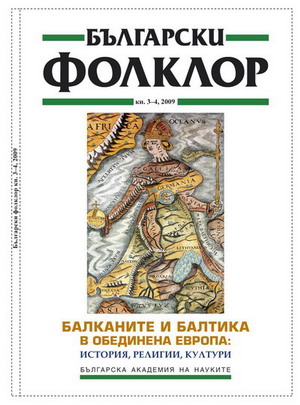Времето и пространството в естонските и българските баения
Time and Space in Estonian and Bulgarian Incantations
Author(s): Mare KõivaSubject(s): Customs / Folklore
Published by: Институт за етнология и фолклористика с Етнографски музей при БАН
Summary/Abstract: I wish to compare Estonian incantations (35 000 texts, one third of them background information) and Bulgarian incantations (collections of I. Todorova-Pirgova, I. Amrojan) in the central philosophical terms of time and space. I used the theory of mental maps by Yi-Fu Tuan (1975) and D. Herman (2001) for modeling incantation-related spatial relationships. It helped find subspaces where characters move freely, distinct objects and living beings exist, and also to find the temporal dimension to which the space is bound. In incantation texts we find an ontologically distinct space that allows communication in exceptional circumstances. Often we find description of both lived space and mythical space in incantation texts. There is also a clear binary presentation of local nearby contra distant spaces. In Estonian spells, mythical space is often connected with Biblical locations (the Jordan River, the Gethsemane Garden, Sinai Mountain, Jerusalem, Nazareth) or imaginary places (for Estonians, the Black Sea), or lived but mythologized distant places (forest, swamp, bog, lake, sea, manor house, neighboring village). In Bulgarian spells we see mythical locations such as Jordan, Tilimiz, White Sea, but also actual far-off locations such as the Danube, the Pirin Mountain, Samokov, the Balkan, Tsarigrad, the Black Sea, mythologized places like pusti gory, pusti les. In Estonia, the rituals of performing incantation were carried out rather in open social space than in the closed space. To analyze time models, I applied S. Tolstaya’s theory of prolonging and compressing time during rituals. These terms are close to what is used for similar phenomena in psychology. At the same time, V. Turner's opinion that ritual is linear, not circular, i.e., it “goes somewhere” rather than returns to where it begins, was a useful insight. Performing a ritual with incantations has its own space-time rules. Space and time in text as well as space and time in performance are connectors between the real time and space and the time and space that have symbolic value. Some incantations are used only on specific holidays of the ritual year; a small number are repeated twice: the starting ritual in the beginning and the period is closed with the ending ritual. For some, the time-target is a lunar phase or weekday, while healing words are often situation-based, time being unimportant.
Journal: Български фолклор
- Issue Year: XXXV/2009
- Issue No: 3-4
- Page Range: 007-015
- Page Count: 9
- Language: Bulgarian
- Content File-PDF

